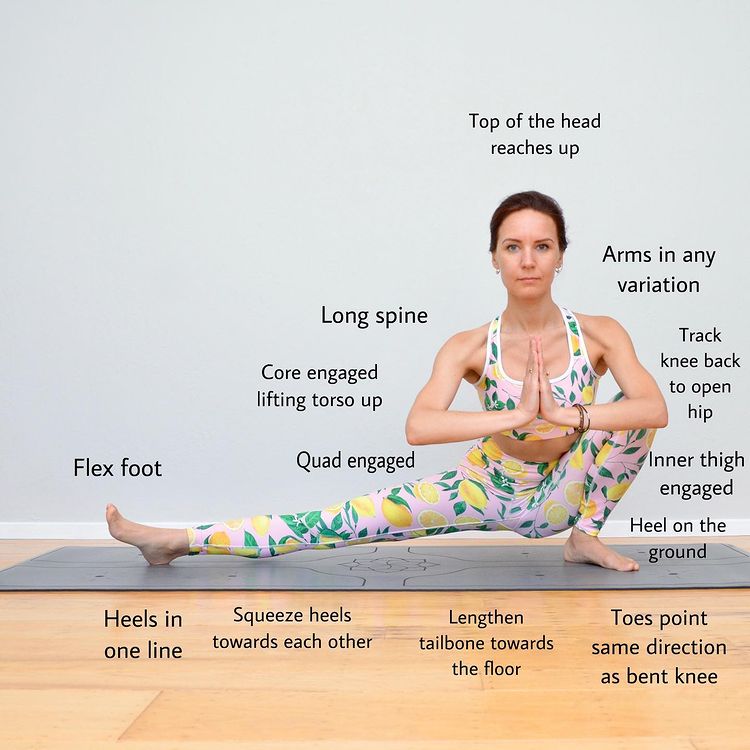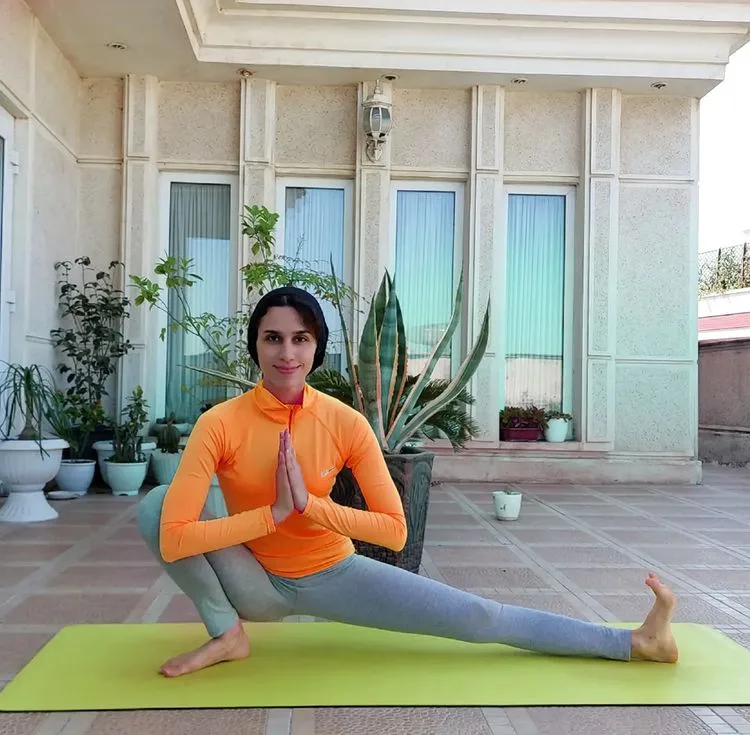Side Lunge Pose, also known as Skandasana, strengthens your lower body while stretches your hamstrings, calves, and groins. The pose also promote the balance and stability.
Side Lunge Pose (Skandasana) can be a great way to build strength, balance and coordination. When you practice stretching the hips and strengthening the legs, you will find more strength and flexibility in all areas of your life!
Information
| Known as: | Side Lunge Pose, Skandasana, Side Lunge Stretch Pose Namaste Hands, Transverse Lunge, Ninja Pose, War Pose |
| Sanskrit name: | स्कन्दासन |
| IAST: | Skandāsana |
| Pronunciation: | skunh-DAHS-uh-nuh |
| Level: | Intermediate |
| Type: | Stretch, balance |
| Focus: | Lower body |
| Total time: | 30 to 60 seconds |
| Drishti: | Forward |
| Chakra: | Svadisthana Chakra, Muladhara Chakra |
| Indications: | Hamstring, calves, groins, respiratory system, internal organs |
| Counterposes: | Janu Sirsasana (Head to Knee Pose), Gomukhasana (Cow Face Pose), Ardha Matsyendrasana (Half Lord of the Fishes Pose) |
| Preparatory poses: | Baddha Konasana (Bound Angle Pose), Prasarita Padottanasana (Wide-legged Forward Fold Pose) |
| Follow-up poses: | Upavistha Konasana (Seated Wide-legged Forward Fold Pose), Malasana (Garland Pose), Ardha Hanumanasana (Half Splits Pose) |
| Contraindications: | Hamstring, groin, or hips injuries, hernia, urinary incontinence, blood pressure |
Meaning + Origins
Skandasana is derived from the Sanskrit name, which is made up of two words – Skanda + Asana:
- “Skanda” = “a warrior’s position during an attack”
- “Asana” = “pose or posture”
Skandasan is dedicated to Kartikeya, the eldest son of Lord Shiva and who is said to be the god of war.
Skandasana can be a great way to understand the concept of “moving prayer,” especially when you allow the body to flow freely from one side to the other. While malas (prayer beads) are used in many spiritual practices to help engage the mind, repetitive physical movement can have the same effect.
Whether you practice the flown version of Skandasana, or use the pose as part of a greeting, give your body and mind enough time to find rhythm and relaxation so that you can enjoy the benefits of the physical embodiment of prayer and meditation.
According to the epic poem, Kumarasambhava, written by Kalidasa; Once a demon named Taraka was causing disturbance among the gods.
He was granted a boon that could only be killed by the son of Lord Shiva; For which Goddess Parvati went to him but Shiva was in deep meditation; To harass Shiva, Kama (the god of love) shot an arrow of desire at him, in response he was burnt to ashes, as soon as Shiva opened his third eye.
After that, to get along with Shiva; Parvati, choosing religious discipline, followed penance and married Shiva; After some time, Kartikeya (Skanda) was born; And after attaining manhood, he destroyed Tarak.
Benefits of Side Lunge Pose (Skandasana)
The physical and mental benefits of Side Lunge Pose are listed below:
- Physical Benefits:
- Strengthens the legs, knee, ankle joints, spine, and core muscles (Abdominis, obliques, etc)
- Stretches the hips, soles, hamstrings, quadriceps, calves, pelvis, groin, and intercostal (muscles between the ribs)
- Improves the respiration
- Opens the hips and legs
- Increases the blood flow to the head, neck, and shoulder region
- Enhances blood circulation in knees and ankle areas
- Improve the flexibility of the hips, hamstring, calves, and pelvic
- Improves the alignment and posture
- Toned back, shoulders, legs, hips, and abdominal
- Stimulates the internal organs, circulatory and metabolic systems
- Activate the pelvic floor muscles
- Calms the entire nervous system
- Improves the stamina
- Mental Benefits:
- Clams the mind
- Reduces anxiety
- Relieves stress
Side Lunge Pose (Skandasana) Practice Guide

Side Lunge Pose is a deep hamstring and adductor stretch, so be sure not to rush into it without preparation. It’s important to activate your legs while in the pose, as well as keeping your sternum as straight as possible to avoid rounding your spine.
This yoga pose is a good way to prepare for an intense yoga practice, but it can sometimes be difficult for beginners to find balance and the right alignment.
Listen to the body and modify the posture as per your need, especially if one has hip or knee problems.
Step-by-Step instructions to Side Lunge Pose (Skandasana)
- Begin the pose by descending into Wide-Legged Forward Bend Pose (Prasarita Padottanasana).
- Now bend the right knee and come to the position of half squat.
- Meanwhile, keep the right leg straight and bend the leg such that the toes lift off the floor as you take root in your left heel.
- Pull hips back, keep your spine straight, and root into your left heel.
- If you want to balance the body, you can use your hands by keeping them on the floor.
- Alternatively, you can bend the elbows and come into Anjali Mudra.
- Stay in the posture for 30 to 60 seconds and then slowly return to the central position where you started the pose.
- This time shift the body weight to the left leg and repeat the process.
Precautions and contraindications
There are some precautions and contraindications to keep in mind while practicing the Side Lunge Pose (Skandasana), which are explained below:
Injury and surgery
Individuals who have any kind of injury to the joints muscles, ligaments related to any part of your body, especially your hips, knees, ankles, spine, pelvic girdle etc should avoid practicing this yoga pose.
If you are recovering from any recent surgery or chronic surgery they should inform yoga teachers/instructors, and even yoga teachers/instructors should be aware of such conditions. This will help you avoid any discomfort caused by the deep strain on your surgery area.
Weak and physical strength
Since this yoga pose requires balance on the toes, which leads to strain on the hips, knees and ankles. Those with weak physical body (recovering from infection, disease, weak bones and joints etc.) should avoid practicing this yoga pose.
Serious conditions such as urinary incontinence or an existing hernia, blood pressure (the act of focusing on balance can affect the heart rate), etc., are considered contraindications, so it is best to avoid practicing the Side Lunge Pose (Skandasana).
Lack of body-breathing connection
Although individuals suffering from asthma can practice this yoga pose, some may find it challenging to balance and breathe. In such circumstances, you must take a decision and keep away from this yoga practice. As you get tired too fast, your body is doing more harm than good.















